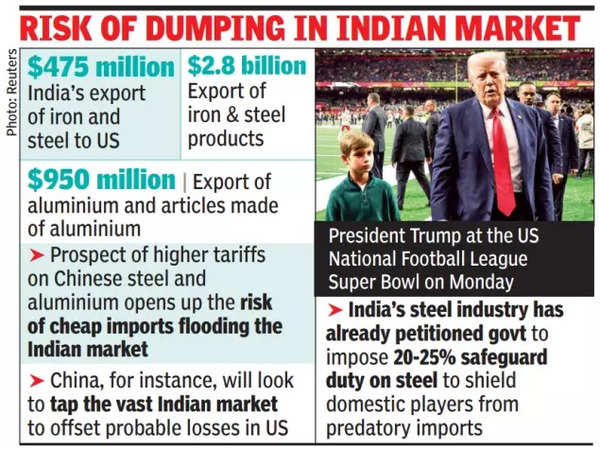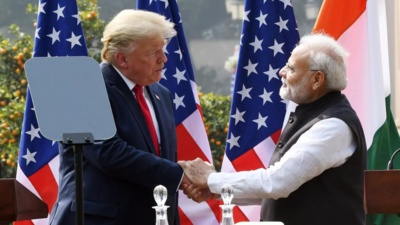NEW DELHI: As President Trump issued fresh threats of 25% tariff on all steel and aluminium imports into the US (on top of existing metal duties), India is getting ready to unbracket itself from countries he has called “worst tariff manipulators”, citing its recent duty cuts to point to a reduction in average duties in recent years.
On Monday, Trump’s economic adviser Kevin Hassett said India has high tariffs that lock out imports, and added that Modi had a “lot to discuss” with Trump as they meet later this week.
Following Budget announcements on tariff cuts for bikes, including the iconic Harley Davidson, and other products in the run-up to PM Modi’s meeting with Trump, officials said they have prepared the ground for the PM to point to Trump that his govt is sensitive to White House’s concerns and has undertaken a comprehensive look at tariffs to bring them down to Asean rates. They also pointed out that the reduction was a signal to the world that tariff rates were not high as perceived by some trading partners.
The reduction in the Union Budget is estimated to have lowered the average duty by a percentage point to 10.6%. Average tariffs on imports from US have also come down over the years. In fact, for the top 30 imports from the US, including oil, gas, diamonds and airplanes, the levy is going up to 7.5% at the most, officials have said.

25% steel tariff won’t hit India’s shipments to US
Officials are also laying store by US’ strategic requirement to have good strategic ties with India, that Trump may not breach New Delhi’s pain barrier on threshold.
Though Modi and Trump have enjoyed a good rapport since the latter’s first term, the govt recognises that nothing can be taken for granted while dealing with a US president who sees himself as a transactionalist with an unrivalled capability to get the best deals for the US.
While the proposed 25% tariff on steel and aluminium has rocked the world, it is unlikely to have a significant impact on India’s shipments to the US. During the last fiscal year, India’s export of iron and steel was estimated at $475 million, with iron and steel products adding up to another $2.8 billion. Export of aluminium and articles made of this metal were estimated at just under $950 million in 2023-24. The largest sources of US steel imports are Brazil, Canada and Mexico, followed by South Korea and Vietnam, according to govt and American Iron and Steel Institute data.
In 2018, the previous Trump administration had imposed 25% tariff on steel and 10% on aluminium, citing national security concerns. These tariffs covered most primary steel products, except stainless steel, and included steel pipes and tubes. The tariffs applied to most countries, triggering a wave of retaliatory measures and escalating tensions in global trade. This had also prompted American auto companies to slash production.
Trump had clubbed India, along with China, Brazil and Mexico, as a high-tariff country and threatened action. So far, however, India has not faced any specific action and both sides have spoken about strengthening trade and economic relations. Modi’s meeting with the US president is expected to only smoothen the process, given the close bond that the two leaders share.
Trump’s announcement pushed up gold prices, seen as a safe haven during turbulent times, while the dollar inched higher. While the sensex closed 550 points lower on Monday, global stocks seem to have shrugged off the threat. Global markets have been on the edge, wary of a possible trade war. The prospect of higher tariffs on Chinese steel and aluminium in particular is, however, not good news for India as the domestic industry is already complaining of cheap imports flooding the markets. This could get worse if Trump goes ahead with his plan, likely Monday, as China would look at the vast Indian market to cover some of the probable losses in the US.
The domestic steel industry has petitioned govt to impose 20-25% safeguard duty on steel to shield domestic players from predatory imports. Small businesses and exporters are, however, wary of these levies and have sought a “balanced response” so that Indian consumers do not end up paying more. An analysis by GTRI showed that India’s iron and steel imports have grown from $10.4 billion in FY2018, when the US-China trade war began, to $18.6 billion in FY2024.


